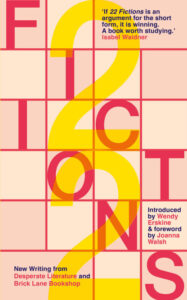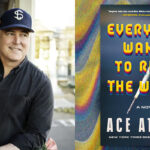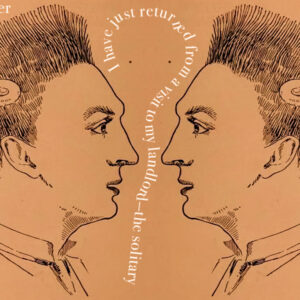
Less Matters More: Joanna Walsh on the Expansive Possibilities of the Short Story
“The memory of these fragments is always created, as a matter of reconstruction. And creation is always hope.”
I was on a book tour in Mexico when I was emailed a dossier of press questions in advance of a reading. One journalist wrote asking, why writing short stories.
“Why writing short stories” is a bit like when Samuel Beckett wrote, “what matter who’s speaking?” a question that splits into import and export. Import is what’s it matter? and export is material. The material that a short story exports is short. There are no other criteria. But still it’s a question. The short story is always in question. It might be the question that matters.
The question I’ve always been asked about the short story is not about the short story at all. It’s when are you going to write a novel? Despite the novelty that the word suggests, this question is never new, though a new novel still hovers eternally in my future, and though I’ve already written two books published as novels, which I didn’t write thinking of them as novels at all.
I don’t think I could have.
I’d like to see a short story praised for its expansiveness because the more something is fragmented, the more surface it has.
For one thing, I don’t think I have novel experience. It doesn’t arc, or follow a narrative: it loops, fragments, seems all beginning or all end, as so much of my experience doesn’t move through time and space but through hope and memory.
Which means it moves through language, and language is a way of speaking matter that isn’t there, or what matters that isn’t there, like when Jonathan Swift’s Gulliver wandered into a country that decreed “that since words are only names for things, it would be more convenient for all men to carry about them such things as were necessary to express a particular business they are to discourse on.”
A novel requires a lot of material, “but for short conversations,” Gulliver discovered, “a man may carry implements in his pockets, and under his arms, enough to supply him; and in his house, he cannot be at a loss. Therefore the room where company meet who practise this art, is full of all things, ready at hand, requisite to furnish matter for this kind of artificial converse.”
Because less matter is required to furnish a short story, less matters more. The short story is not Walter Benjamin’s “monumentally furnished ten-room apartment,” which is how he described the nineteenth-century novel (Benjamin names Gaston Leroux’s 368-page The Phantom of the Opera as its “apotheosis”) whose “gigantic sideboards distended with carvings, the sunless corners where palms stand, the balcony embattled behind its balustrade, and the long corridors with their singing gas flames, fittingly house[s] only the corpse. On this sofa the aunt cannot but be murdered”
Now we furnish with IKEA: flatpack, convenient, able to be set up anywhere, able to furnish a room in the way of Swift’s short conversations. When everything is flatpack, everything is surface, surfaces that can be put together to create an illusion of volume. In a small space, the short story writer needs to be able to use surfaces. These are the surfaces of language. Inverting the object-oriented society that Swift describes, short story writers trade in illusion.
Writers of short stories furnish small spaces—not ten-room apartments—with immateriality that, fragmented, creates the illusion of volume. The fragment has been a thing ever since around the time Swift was writing, when rich Northern Europeans started touring the Mediterranean in search of encounters with leftover fragments of the classical world, the “Grand Tour,” an experience that Gulliver’s Travels pastiches.
Swift’s description of language as matter is a matter of international politics: “thus ambassadors would be qualified to treat with foreign princes, or ministers of state, to whose tongues they were utter strangers.” No surprise. In 1726 the British Empire was already expanding in the name of trade, trading the immaterial language Swift wrote in for material goods. Language is not a material good. Jacques Derrida wrote that it’s a poison. Gaston Leroux turned to short story writing in the pursuit of material goods after spending his large inheritance.
Leroux is listed on Wikipedia as a “short story writer” although his best-remembered work is a novel. He might have been a short story writer because of the culture of the short story, the contemporary monthly and weekly publications that made writing short stories, in his era, a viable trade. But writing short stories is no longer a viable trade, as writers who choose to write short stories find: When are you writing a novel?
Who are the short story writers, these traders in fragments: the grand tourists, or the inhabitants of fragmented landscapes building pillars into single-room apartments to be furnished with flatpack furniture? Or either, likely either. Or both, which is either’s opposite. In any case their fragmented material conveys hope and memory. Because the memory of these fragments is always created, as a matter of reconstruction. And creation is always hope.
Any writing is created from excavation: columns out of the dead ground. When I’m writing, I never think about making things up. The matter I write is waiting to be discovered/exhumed/whatever. If I’m extractive, I’m self-extractive. Is that a good thing? I don’t know. I don’t have a choice. That’s how I teach writing too: I tell students, you know it already. No need to learn, only to “pick out,” as Georges Perec wrote, “what you’ve long ago picked out.” He wasn’t writing about the short story but, when you get your material everywhere, why not apply it?
It’s like when Chris Kraus told me that all novels are about real estate. Well that’s novels, with their ten-room apartments. Perec wrote about apartments too, in Species of Spaces. Though a room is “a fairly malleable space,” despite any architect’s intentions, and “it is no good their trying to impress us with stuff about modules, and other nonsense.”
Short stories are for tenants, those who are aware that they are in a holding space. The short story writer doesn’t have to build and doesn’t have to respect the architect’s intentions. That’s because language isn’t really an exchange of objects, only their surfaces.
But these are just some short stories. There are a thousand definitions, more, many of which lay down rules on how to build short stories, brick by brick. And a novel doesn’t have to be a grand apartment. It can be a painting on a “little bit of ivory.” Whatever, I’m not one for rules or craft, more for bricolage, for rearranging the furniture, or taking it apart and making it into something else, an IKEA hack, something you can do in a small space, Lautrémont’s “chance encounter of a sewing machine and an umbrella on an operating table,” which is a very post-what-gets-called-the “industrial revolution” range of objects and processes.
The short story is a reconfigurable, expansive surface of the immaterial material, of hope and memory, that is always bigger than the small room that only appears to contain it.
Which novels and short stories are too. Gulliver’s Travels doesn’t really count as a novel. It’s sometimes called a “protonovel” and it was part of the emergence of the form during the eighteenth century, which also led to the emergence of the short story or, rather, the division of narratives into long and short, and both are something to do with the industrial revolution, with printing presses and newspapers, and railway stations, and education, and remoteness, and time spent between places, long or short. The Grand Tour stopped being a thing when the railways arrived.
A short story is an economic fact, and so is a novel. That’s even before you’ve got to either’s material. Each is defined by the systems that allow them to exist—like the prizes from which this collection is drawn, like independent bookshops and journals, and like this book—that encourage, that publish, that finance them. Short stories are often praised for their “economy,” which suggests a certain perspective. I’d like to see a short story praised for its expansiveness because the more something is fragmented, the more surface it has.
As writing becomes more portable, we have become less so. Now we work from home on our flatpack furniture. Wherever we are, we work “remotely,” always ready to move but never moving. The short story used to be fable, then anecdote. Now it’s something else. The short story is a reconfigurable, expansive surface of the immaterial material, of hope and memory, that is always bigger than the small room that only appears to contain it. It is a way of questioning spaces and the things in it, which is a way of questioning the distribution of space and those things, which is a way of questioning the distribution of language: what matter who’s speaking? It is a question.
When the journalist asked me, why writing short stories, unlike Beckett they didn’t use a question mark. It was—like the contribution dreaded at readings—not so much a question as a comment: for why. In which case, I could have answered, yes.
__________________________________

From 22 Fictions: New Writing from Desperate Literature and Brick Lane Bookshop, edited by Kate Ellis and Robert Loyko-Greer. Copyright © 2025. Introduction copyright © 2025 by Joanna Walsh. Available from Cheerio Publishing.
Joanna Walsh
Joanna Walsh a multidisciplinary writer for print, digital narrative, installation and performance. The author of twelve books, including several written with AI she hand-coded, her publishers include Semiotext(e), Bloomsbury and Verso. She is a UK Arts Foundation fellow, a Markievicz Award and DAAD awardee. She has also worked as an editor, illustrator, academic researcher and arts activist. She founded and ran #readwomen (2014-18), described by the New York Times as 'a rallying cry for equal treatment for women writers', and @noentry_arts (2019-2024), changing the conversation around age and arts opportunities. She writes a monthly fashion and theory column, 'Theory of Style', at Spike Art Magazine.


















